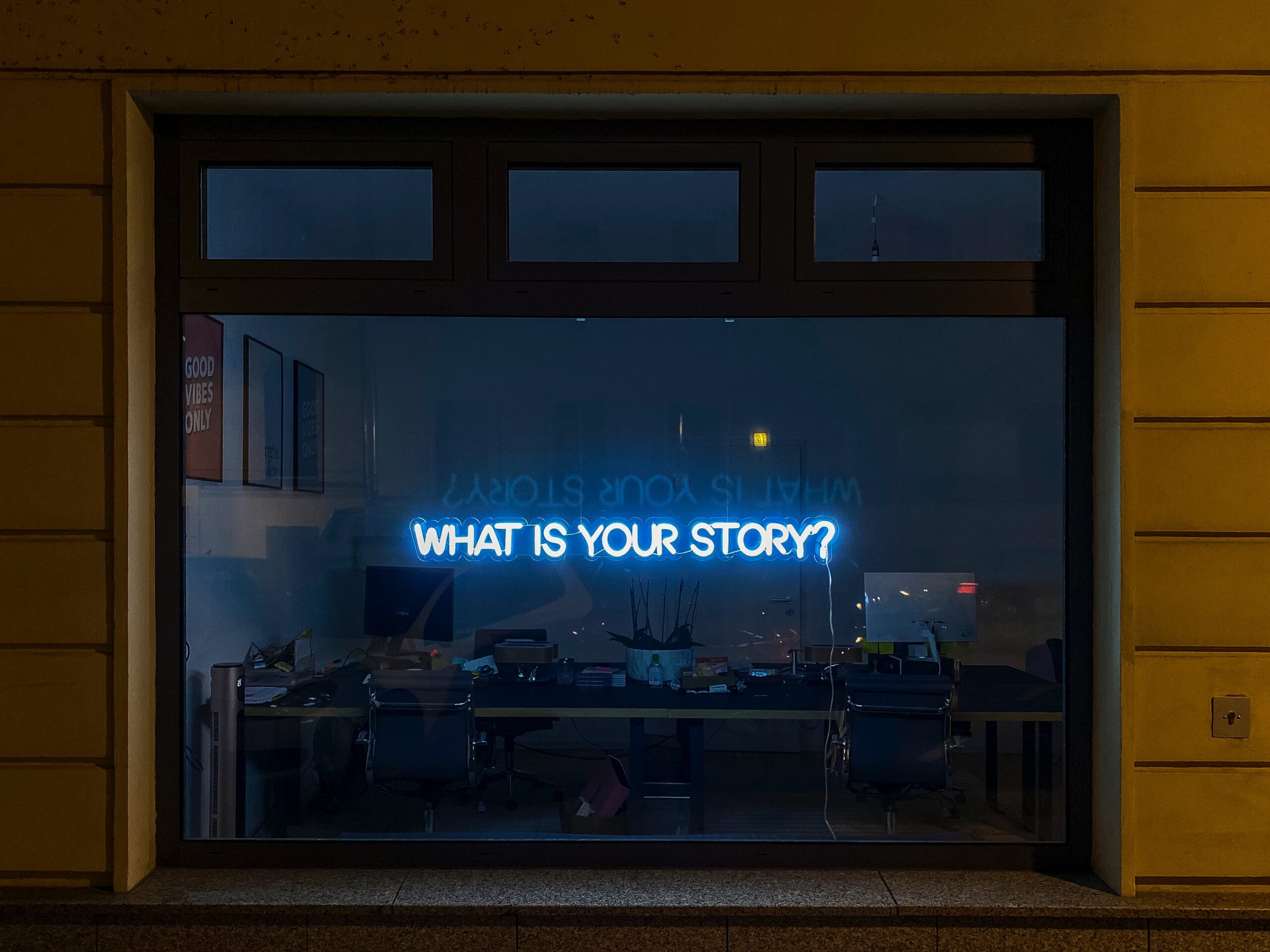Making it sell
Nothing new in storytelling, but can the research world make better use of the genre?
Sitting comfortably? Let us begin.
The advertising copywriter did the same walk to work most days. A deep sense of sadness consumed him as he passed by an old man begging on the street corner. He noticed the beggar’s tin was completely empty. Winter was on its way and donations had dried up.
Next to the dented tin was a worn piece of cardboard bearing the old man’s pitch:
‘I am blind. Please give.’

The young man wanted to give money and often he did. But he wondered whether there was anything else he could do. It weighed heavily on his mind until inspiration came.
He stopped and kneeled next to the old man and said,
“My name is Peter. I would like to help you.” The old man turned his head towards the sound of the helpful voice.
“Would you object if I wrote a new message on your piece of cardboard?”
“What have I got to lose? I haven’t heard a single coin land today. Be my guest,” said the old man.
Peter pulled out his black felt-tipped pen, turned the cardboard over and wrote down a single sentence. He neatly placed the cardboard back next to the tin, said his goodbyes and left. All morning, Peter wondered whether his idea had worked. He returned in his lunch hour where he found a much happier old man. It was hardly surprising. His tin was brimming with coins.
“What did you write on my board? I am very grateful and very curious. But you never said and I have listened to coins land in my tin all morning.”
He read out the words that had inspired so many people to give.
“Today is a beautiful sunny day. You can see it. But I cannot.”

The power of story
The blind beggar’s story tells us how storytelling can inspire people to behave differently.
While storytelling has become a buzzword in marketing circles, the subtleties of good storytelling have been lost somewhere along the way – particularly in research. Many still think that stories extolling the virtues of a brand, or new products are just what an audience wants. But does it? Does anyone really care about your message, your brand, or how pleased you are to announce the launch of Version 2.0 of whatever product you are flogging?
The mistake is thinking the story is about the product when really the best stories are the ones that involve the product.
Let’s say I wanted to engage your interest in my particular brand of washing powder. Do you want to know that it is concentrated, that it smells nice, that it has an amazing set of enzymes and colour guards that will render all your clothes whiter than white? Does this list of features connect with your emotional brain such that you want to buy my washing powder?
Storytelling often starts with the counterintuitive – defying expectation or challenging conventional thinking altogether. That was the wisdom behind one of Unilever’s iconic brands when Persil was given the storytelling treatment in a campaign that has since won more effectiveness awards than any other. The creative team at Lowe and Partners tuned in to what mums have known all along – that children need the freedom to experience, develop and grow and that means getting dirty. The ‘Dirt is good’ campaign has defined the Persil brand ever since in more than 60 countries and the spin-off campaigns keep coming ten years later.
Advertising copywriters have been using classic storytelling techniques for decades. Will we ever forget Yellow Pages and JR Hartley’s search for ‘Fly Fishing?’ Or what about Compare-TheMarket’s meerkats campaign which continues to engage and entertain the British viewing public in a unique and memorable way?
Arguably, it is the research sector that is perfectly placed to maximise story, but often gets it wrong. Take a look at a lot of research published – Although factual, it tells a dull story, without thinking about what is interesting or why the research was conducted in the first place.
So what exactly is storytelling and how can it be applied to the process of research? More importantly, how can research storytelling influence sales?
The ways in which businesses can harness the power of story go beyond the press release. The sales team on an exhibition stand, the CEO presenting to the board, the weekly staff meeting; all are situations where storytelling can inspire action.
The great orators of history know that storytelling takes root in the emotional brain. Movements are created when audiences are inspired – notably from Gandhi to Martin Luther-King to Winston Churchill.
Great storytelling causes people to see and feel something in a way that a list of bullet points cannot.
The anatomy of a good story
We can learn a great deal from the author of a book or a scriptwriter of a play to understand how we can make our next research campaign worthy for PR.
An author cannot take it for granted that you will keep turning the pages of their book unless you are emotionally engaged in the content. So the first element to the story design is having a plot.
Professional storytellers, such as journalists, will tell you that good news doesn’t sell. The same applies to the plot of a film or a book. So what does?

Bad news sells
Bad news is what drives the daily news agenda of virtually every news headline. The plot of your story needs tension; a struggle, some kind of conflict at its heart. Your audience will relate better to a problem because it’s the basic premise of gossip. So how do we apply this technique in practical terms when you simply have a widget to sell?
Every invention ever created is designed to solve a problem. Find the fundamental problem your product or service solves and build a drama around it.
Let’s take a plastic desk tidy – a small object that sits on the desk, holding pens and paper clips.
The manufacturer will be tempted to list the features and benefits of their desk tidy and even give it a name. The company will tell you that you can order it in an array of bright colours. And it is made from longlasting durable plastic. It will hold as many as ten pens, paper clips and pieces of paper. And it’s fire-proof.
This is not storytelling.
Now let’s look at the message through a different lens.
A more imaginative way would be to create a drama caused by untidy desks (the problem). Could this be a story about poor productivity (unfolding drama) or can we spark curiosity by illustrating what an untidy desk may say about you? We could even show pictures of the desks of famous people with insights from a psychologist hired by the manufacturer. The creative possibilities are endless. If this were a piece of research then, what would it look like?
‘Untidy desks to blame for 80% of poor productivity and competitiveness of business, according to research by Universal Plastics (at the launch of its TidyBox range’)…
Better.
The human touch
Another technique favoured by the professional storyteller is to weave human interest into the plot. The audience will relate better to the story if it can identify with the characters or personalities. There is invariably a victim or a hero or both in a given plot of a book.
Again, our friends at Universal Plastics could take heed. Could we conduct some qualitative interviews with someone famous for being highly productive who always insists on having a tidy desk? Could that person bring a personal anecdote to the party that might back up the claim that poor productivity is the outcome of untidy desks? Can we refer to the great works of this famous person? A film director, or inventor, or scientist perhaps? If they are known for prolific output, the message could link nicely to the message.

Topical
Timing is often a consideration. The audience may relate better to your research if there is a seasonal angle. Might the Universal Plastics product launch work better earlier in the New Year as office workers are returning to work and perhaps more open to different working practices at the start of a year than, say, in the summer? Is there such a thing as ‘Office Tidy-up Day?’ Could you create one if there isn’t?

The best stories?
Let’s come back to the Persil campaign and understand why it was so successful. It beautifully encapsulated all three dimensions in a single story. The ‘bad news’ or tension is dirt. It is there in your face. It contains all the drama in brutal simplicity, surprising an unsuspecting audience and grabbing attention in the process. The human interest is self-evident. Mums are the target audience and now they are an active participant in the story itself. Mums know dirt is good because they know their children are exploring, and that is healthy. As an observer, we can also see children at play. And that is good also. Topicality abounds in this story, because we want our children to put down their computer games and get active. This story plays superbly well in this context.
Undoubtedly, the best stories are the ones that feature all three dimensions but it also plays equally well in a b2b and b2c context.
The anti-virus software company Kaspersky Lab in the uk once put out a compelling piece of content to coincide with Safer Internet Day by bringing all three elements into a single story that went on to achieve widespread coverage in national press, lifestyle and broadcast media globally.
Using desk research, they identified how easy it would be for a young child watching Peppa Pig or Postman Pat on YouTube to find themselves watching inappropriate adult material. The answer was just three clicks. And so the headline was born.
The Three Clicks from Danger press release went on to be nominated for countless awards and was heralded as an example of best pr practice after achieving a global spread of more than 400 clippings across broadcast, online and in traditional print media.
There is no question, research could do with an injection of creative storytelling more often along these lines. Importantly, the integration of the story across multiple channels, integrating the processes of pr with social and digital marketing is key to success. Stories get shared. Stories appeal emotionally. Stories drive action.
Now that we have more platforms to communicate from, the challenge for any pr and marketing team executive is not how to execute multi-channel, but how to originate an idea in the first place. Sadly, we see many so-called examples of storytelling which fail to hit the spot.
Simon Sinek’s ‘Start with Why’ philosophy is a great place to begin where the message is not what you do or how you do it differently. It is why you do it. Identify your cause, your belief, your passion and build a storytelling platform congruous with your brand strategy and messaging. Then make sure you can easily bridge from the story to the brand of product you are pushing.
Only then will your story have the happy ending that every business wants. And what every business wants is more sales. Maybe we should call it storyselling.

Tips for successful storytelling
What is the title? If your company were a book, what would you call it?
Remember the cornerstones of a compelling story: Bad news. Human interest. Relevant.
Think in terms of LOTS (language of the senses) so the audience can see, feel, smell, even touch your story.
In order to be a story, you need a plot with a tipping point, emotion, characters, a problem and a resolution.
Think in graphical terms: show, not tell.
Give your story dialogue from one or more of your characters.
Deploy the magic of metaphor.
If stuck, start with; What if?

